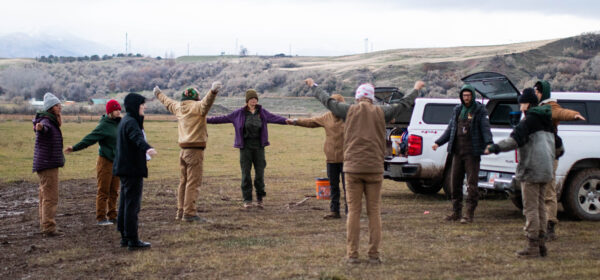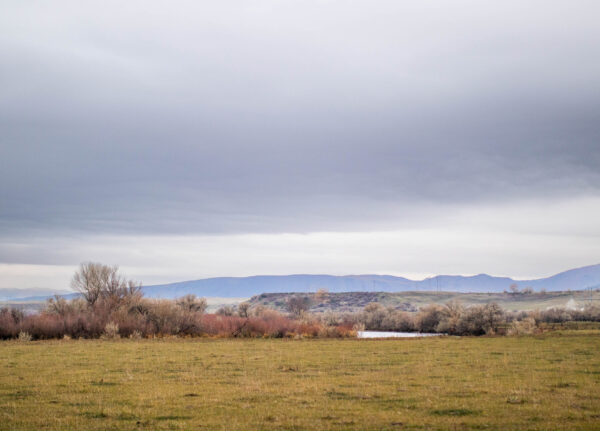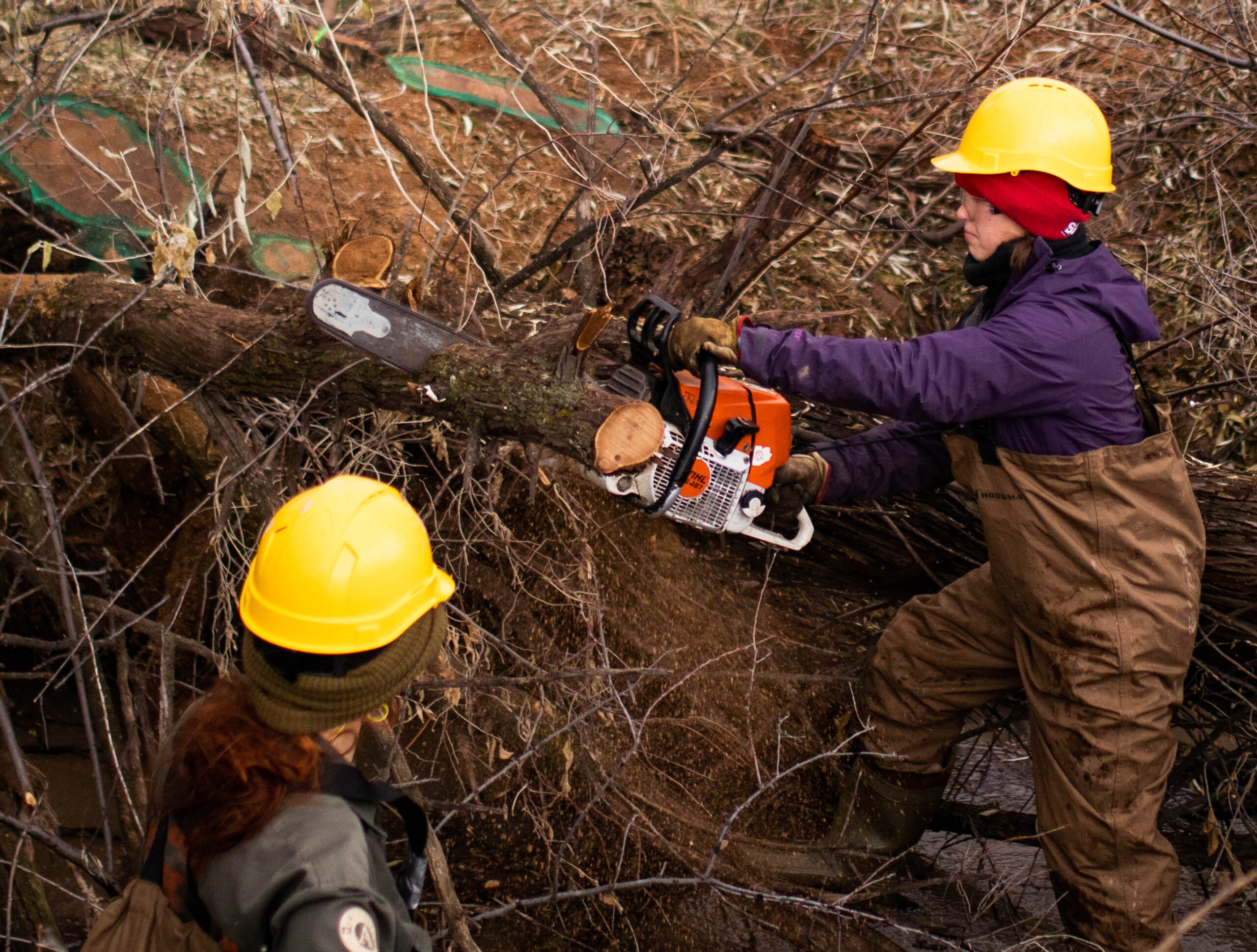Northwestern Shoshone plan to build cultural interpretive center at Bear River Massacre site
At 7 a.m. on Nov. 11, Nora Sackett led her 10-person crew through their daily “stretch and safety” in a muddy field near Preston, Idaho.
Everyone took a turn leading the group in a stretch, shared a safety tip for the day and then chose which field tool they’d want in a zombie apocalypse.
After stretching, the crew set up their chainsaws and got to work cutting down trees.
Sackett is a field boss from the Utah Conservation Corps, or UCC, a program in Utah State University’s Center for Community Engagement.
 Bailey Rigby
Bailey Rigby The UCC meet every morning at 7 a.m. to do “stretch and safety,” where they each take turns sharing a stretch, a safety hazard and an answer to the question of the day.
Since Oct. 26, the UCC has been working to restore the habitat at the Bear River Massacre site to its pre-agricultural condition.
The crew camps out on the land and works from 7 a.m. to 5:30 p.m. cutting down trees and treating the stumps with herbicide, so they won’t grow back.
The crew has mainly been working to remove Russian olive trees, which were brought to the land to help with stream bank erosion. But, according to Jake Oakden, the northern technical coordinator for the UCC, these trees outcompeted the natural plant species and caused channelling issues.
“The hope is that by removing a lot of the Russian olive that they’re going to be able to work on, kind of, bringing the stream back to a more natural state,” Oakden said.
The crew works in eight-day hitches and will finish their second and final hitch on Nov. 16.
The habitat restoration is just one part of the Northwestern Band of the Shoshone Nation’s plan to build a cultural interpretive center where the Bear River Massacre took place more than 150 years ago.
The Bear River Massacre, also known as the Massacre at Boa Ogoi, is the largest mass killing of Native Americans in U.S. history. Nearly 400 Shoshone were killed by the United States Army California Volunteers on Jan. 29, 1863.
In 2018, the tribe purchased the land where the massacre took place and has been working on plans to build the center since.
Brad Parry, the vice chairman and program manager of the Northwestern Band of the Shoshone Nation, said the tribe hired engineers from Hansen, Allen & Luce Inc. and biologists from Bio-West Inc. to put together a plan for habitat restoration, along with help from USU’s Climate Adaptation Science program.
“As a tribe, we felt that there was no point in having a cultural center if we didn’t culturally return the land back to what it may have been like when we were last there in the 1860s,” Parry said.
Sackett said it’s been cool to work on a project with so much significance.
“On the first day there was a ceremony, and they blessed us,” she said. “The tribe blessed us and blessed the site, so that was super cool to have this experience where we feel actually connected to the work we’re doing.”
Plans for the outdoor portion of the center include on-site nurseries and walking trails through the massacre site.
“Along the way we’ll be able to identify trees and plants and different things that the tribe uses medicinally or for food or culturally,” Parry said, “and we want people to be able to walk through there and see that this is a living nursery.”
Parry said they are anticipating the habitat restoration will take three to four years, but the tribe plans to break ground on the interpretive center next summer.
 Bailey Rigby
Bailey Rigby The cultural interpretive center will be built on the bluff overlooking the massacre site.
Darren Parry, a council member of the Northwestern Band of the Shoshone Nation — and first cousin to Brad Parry — said that the inside will feature exhibits that change with the seasons to reflect the Shoshone’s changing lifestyle.
“We’re not going to charge to have anybody go, so, you know, it’s not a money thing,” Darren said, “but I just wanted people to be able to go back often and hear the story of the plants and see what was important to the Shoshones at certain times of the year.”
Students in professor Holly Murdock’s commercial interior design studio class are working together with the tribe to design the floor plan of the interpretive center.
Because storytelling is so important to the Shoshone, Murdock challenged her students to design the building in a way that tells a story.
Ashtyn Mendenhaal, a junior in the interior design program, said she designed her floor plan to pull visitors in like a story would.
“It’s really emotional, I think, when you read a story and you get tied down to that,” Mendenhaal said, “and I think that the cultural center in general should be an emotional attachment that people feel as they’re walking through the space.”
The interpretive center will sit on a bluff overlooking the massacre site, with a bird’s eye view of where the bodies of the Shoshone lay beneath the surface. Even though the center will teach guests about the massacre, it’s not meant to be a place of sadness.
“They ultimately want it to be a place of joy and unity,” Murdock said. “They want everyone, regardless of who they are or where they’re from, to come there and feel welcome.”
It’s also meant to be a place of learning, where visitors can learn from the tragic mistakes of the past.
As a child, Darren remembers his grandmother Mae Timbimboo Parry telling him, “No one has ever wanted to hear our story before. One day you will have to make them listen.”
Though his grandmother passed away years ago, Darren has felt a responsibility to make sure the Shoshone story is told, so visitors can learn from it.
“Those voices — those people that were massacred that day — their voices cry to me from the dust,” he said. “They need their story told.”
Editor’s note: A previous version of this article incorrectly reported that the Russian olive trees caused erosion at the Bear River Massacre site. The article has been updated and is now accurate.

